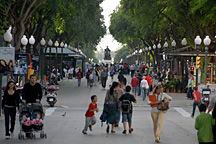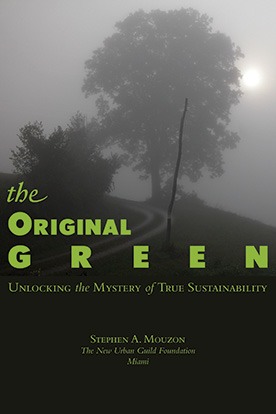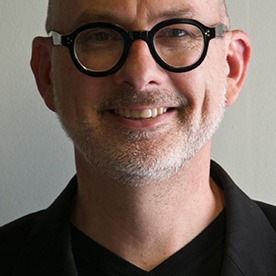
Pedestrian Propulsion is a characteristic of a street that entices you to walk further than you otherwise would on lesser streets... literally propelling you along the way. It’s why you might walk for miles through the streets of Paris on a dreary day, stopping only when the showers come down, and even then under an awning at a little sidewalk cafe where you can continue on your way just as soon as the rain moves off.
The opposite of Pedestrian Propulsion is Pedestrian Obstruction. This is what happens in the parking lot of a “power center,” where the pedestrian experience is so bad that we all get in our cars to drive from the Old Navy to the Best Buy.


New Urbanists talk a lot about the 5-minute walk, which is roughly a quarter-mile. In theory, the average adult will walk rather than drive to their destination if it’s less than 5 minutes away. But as we have seen, Pedestrian Propulsion can dramatically increase this distance on a network of great streets like those found in central London, Rome, Paris, Charleston, Boston, etc. And Pedestrian Obstruction can dramatically shorten it. How far do you really want to walk in a sea of parking? “No further than absolutely necessary,” is likely your answer.
How does this work? Pedestrian Propulsion seems to depend on several factors. Foremost among them is something I call “Pedestrian Entertainment.” Simply put, the more you entertain the eyes of the pedestrians, the further they will walk. Some of this entertainment occurs simply because of geometry. If the sidewalk is closer to the buildings, then your view can change more frequently. But if the buildings are set far back from the sidewalk, then it takes a long time for your view to change appreciably. Imagine walking along a Main Street with storefronts at your elbow. Now imagine walking along a sidewalk in an office park, with the boring office buildings set hundreds of feet off the street. It’s clear why nobody walks in an office park, isn’t it?

The width of the buildings matter, too. You walk by narrower buildings on narrower lots more quickly than wide ones. The interest of the building design is also important. A blank wall is deadly to pedestrian interest, while a storefront full of attractive wares probably enhances Pedestrian Entertainment (and therefore increases Pedestrian Propulsion) as much as anything.
Interestingly, one of the things we find most entertaining is other people. Streets full of people often attract even more, while deserted streets can be spooky. It seems as if the rich get richer and the poor get poorer... pedestrian-rich or pedestrian-poor, that is. But this isn’t really true, because if you create a fabric of streets that entice pedestrians, then there will be plenty to go around. But if it’s an auto-dominated place, then nobody will walk even if there are occasional good blocks. My home is a classic example. Go north of 21st Street on Miami Beach and all you can find are cars. But on South Beach, people are walking everywhere... so much so that South Beach has been dubbed “the 21 Most Exciting Blocks on Planet Earth.”
~ Steve Mouzon
Legacy Comments:
Friday, July 31, 2009 - 10:25 AM
Ken Firestone
Steve,
Has anyone done any research on this specifically?
Friday, July 31, 2009 - 10:27 AM
Ken Firestone
Besides this:
I have a copy of the complete paper.


